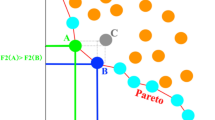Abstract
The Set Covering Problem (SCP) has been an extensively studied NP-hard problem in the field of combinatorial optimization since 1970. Over the past five decades, a significant amount of research has led to the development of a diverse set of covering models to support decision-making in various areas. However, the SCPs related to real-world applications are often too complex to solve using existing algorithms due to uncertain problem parameters. Thus, given the diversity of new developments, there is a pressing need to know both the current solution approaches and the advanced strategies for studying the uncertain SCP. This study summarizes the various modeling and solution approaches to the SCP when the model parameters are uncertain. Further, this study discusses some promising future research directions of the uncertain SCP that will impact new investigations of decisions on complex and competitive real-world issues.
Similar content being viewed by others
References
Ahmed, S., & Papageorgiou, D. J. (2013). Probabilistic set covering with correlations. Operations Research, 61(2), 438–452.
Aly, A. A., & White, J. A. (1978). Probabilistic formulation of the emergency service location problem. Journal of the Operational Research Society, 29(12), 1167–1179.
Bandara, D., Mayorga, M., & McLay, M. (2012). Optimal dispatching strategies for emergency vehicles to increase patient survivability. International Journal of Operational Research, 15(2), 195–214.
Bélanger, V., Ruiz, A., & Soriano, P. (2019). Recent optimization models and trends in location, relocation, and dispatching of emergency medical vehicles. European Journal of Operational Research, 272(1), 1–23.
Benveniste, R. (1982). A note on the set covering problem. Journal of Operational Research Society, 33, 261–265.
Beraldi, P., & Ruszczyński, A. (2002). A branch and bound method for stochastic integer problems under probabilistic constraints. Optimization Methods and Software, 17(3), 359–382.
Beraldi, P., & Ruszczyński, A. (2002). The probabilistic set-covering problem. Operations Research, 50(6), 956–967.
Beraldi, P., & Ruszczyński, A. (2005). Beam search heuristic to solve stochastic integer problems under probabilistic constraints. European Journal of Operational Research, 167(1), 35–47.
Bettinelli, A., Ceselli, A., & Righini, G. (2014). A branch-and-price algorithm for the multi-depot heterogeneous-fleet pickup and delivery problem with soft time windows. Mathematical Programming Computation, 6(2), 171–197.
Borrás, F., & Pastor, J. T. (2002). The ex-post evaluation of the minimum local reliability level: An enhanced probabilistic location set covering model. Annals of Operations Research, 111(1), 51–74.
Cabeza, M., Araújo, M. B., Wilson, R. J., Thomas, C. D., Cowley, M. J., & Moilanen, A. (2004). Combining probabilities of occurrence with spatial reserve design. Journal of Applied Ecology, 41(2), 252–262.
Chvatal, V. (1979). A greedy heuristic for the set-covering problem. Mathematics of Operations Research, 4(3), 233–235.
Coco, A. A., Santos, A. C., & Noronha, T. F. (2022). Robust min–max regret covering problems. Computational Optimization and Applications, 83(1), 111–141.
Daskin, M. S., & Stern, E. H. (1981). A hierarchical objective set covering model for emergency medical service vehicle deployment. Transportation Science, 15(2), 137–152.
Deb, K., & Kumar, A. (2007). Light beam search based multi-objective optimization using evolutionary algorithms. In 2007 IEEE congress on evolutionary computation (pp. 2125–2132). IEEE.
Degel, D., & Lutter, P. (2013). A robust formulation of the uncertain set covering problem. Technical report, Ruhr-University Bochum.
Ding, S., Zhang, Q., & Yuan, Z. (2020). An under-approximation for the robust uncertain two-level cooperative set covering problem. In 2020 59th IEEE conference on decision and control (CDC) (pp. 1152–1157). IEEE.
Farahani, R. Z., Asgari, N., Heidari, N., Hosseininia, M., & Goh, M. (2012). Covering problems in facility location: A review. Computers & Industrial Engineering, 62(1), 368–407.
Fischetti, M., & Monaci, M. (2012). Cutting plane versus compact formulations for uncertain (integer) linear programs. Mathematical Programming Computation, 4(3), 239–273.
Florios, K., & Mavrotas, G. (2014). Generation of the exact pareto set in multi-objective traveling salesman and set covering problems. Applied Mathematics and Computation, 237, 1–19.
Grossman, T., & Wool, A. (1997). Computational experience with approximation algorithms for the set covering problem. European Journal of Operational Research, 101(1), 81–92.
Haight, R. G., Revelle, C. S., & Snyder, S. A. (2000). An integer optimization approach to a probabilistic reserve site selection problem. Operations Research, 48(5), 697–708.
Hammer, P. L., & Bonates, T. O. (2006). Logical analysis of data: An overview: From combinatorial optimization to medical applications. Annals of Operations Research, 148(1), 203–225.
Hwang, H.-S. (2002). Design of supply-chain logistics system considering service level. Computers & Industrial Engineering, 43(1–2), 283–297.
Jaszkiewicz, A. (2003). Do multiple-objective metaheuristics deliver on their promises? A computational experiment on the set-covering problem. IEEE Transactions on Evolutionary Computation, 7(2), 133–143.
Kohl, N., & Karisch, S. E. (2004). Airline crew rostering: Problem types, modeling, and optimization. Annals of Operations Research, 127(1–4), 223–257.
Lemke, C. E., Salkin, H., & Spielberg, K. (1971). Set covering by single-branch enumeration with linear-programming subproblems. Operations Research, 19(4), 998–1022.
Lowerre, B. T. (1976). The harpy speech recognition system. Pittsburgh: Carnegie Mellon University.
Lutter, P., Degel, D., Büsing, C., Koster, A. M., & Werners, B. (2017). Improved handling of uncertainty and robustness in set covering problems. European Journal of Operational Research, 263(1), 35–49.
Marchiori, E., & Steenbeek, A. (2000). An evolutionary algorithm for large scale set covering problems with application to airline crew scheduling. In 41st Annual symposium on real-world applications of evolutionary computation, workshops (pp. 370–384). Berlin: Springer.
Marchiori, E., & Steenbeek, A. (2000b). An evolutionary algorithm for large scale set covering problems with application to airline crew scheduling. In Workshops on real-world applications of evolutionary computation (pp 370–384). Springer.
Marianov, V., & Revelle, C. (1994). The queuing probabilistic location set covering problem and some extensions. Socio-Economic Planning Sciences, 28(3), 167–178.
Marsten, R. E., & Shepardson, F. (1981). Exact solution of crew scheduling problems using the set partitioning model: Recent successful applications. Networks, 11(2), 165–177.
McDonnell, M. D., Possingham, H. P., Ball, I. R., & Cousins, E. A. (2002). Mathematical methods for spatially cohesive reserve design. Environmental Modeling and Assessment, 7(2), 107–114.
NETLIB. (2013). http://www.netlib.org/lp/data/.
ORLIB. (1990). http://people.brunel.ac.uk/~mastjjb/jeb/info.html.
Pereira, J., & Averbakh, I. (2013). The robust set covering problem with interval data. Annals of Operations Research, 207(1), 217–235.
Powell, W. B. (2019). A unified framework for stochastic optimization. European Journal of Operational Research, 275(3), 795–821.
Prins, C., Prodhon, C., & Calvo, R. W. (2006). Two-phase method and Lagrangian relaxation to solve the bi-objective set covering problem. Annals of Operations Research, 147(1), 23–41.
ReVelle, C., & Hogan, K. (1989). The maximum availability location problem. Transportation science, 23(3), 192–200.
ReVelle, C., & Marianov, V. (1991). A probabilistic fleet model with individual vehicle reliability requirements. European Journal of Operational Research, 53(1), 93–105.
Sabuncuoglu, I., & Bayiz, M. (1999). Job shop scheduling with beam search. European Journal of Operational Research, 118(2), 390–412.
Saxena, A., Goyal, V., & Lejeune, M. A. (2010). MIP reformulations of the probabilistic set covering problem. Mathematical Programming, 121(1), 1–31.
Saxena, R. R., & Arora, S. (1981). Exact solution of crew scheduling problems using the set partitioning model: Recent successful applications. Optimization, 11(2), 165–177.
Schilling, D. A. (1993). A review of covering problems in facility location. Location Science, 1, 25–55.
Slavík, P. (1996). A tight analysis of the greedy algorithm for set cover. In Proceedings of the twenty-eighth annual ACM symposium on theory of computing (pp. 435–441).
Soyster, A. L. (1973). Convex programming with set-inclusive constraints and applications to inexact linear programming. Operations Research, 21(5), 1154–1157.
Toregas, C., Swain, R., ReVelle, C., & Bergman, L. (1971). The location of emergency service facilities. Operations Research, 19(6), 1363–1373.
Wang, W., Wu, S., Wang, S., Zhen, L., & Qu, X. (2021). Emergency facility location problems in logistics: Status and perspectives. Transportation Research Part E: Logistics and Transportation Review, 154, 102465.
Weerasena, L. (2020). Algorithm for generalised multi-objective set covering problem with an application in ecological conservation. International Journal of Mathematical Modelling and Numerical Optimisation, 10(2), 167–186.
Weerasena, L., & Wiecek, M. M. (2019). A tolerance function for the multiobjective set covering problem. Optimization Letters, 13(1), 3–21.
Weerasena, L., Shier, D., & Tonkyn, D. (2014). A hierarchical approach to designing compact ecological reserve systems. Environmental Modeling & Assessment, 19(5), 437–449.
Weerasena, L., Wiecek, M. M., & Soylu, B. (2017). An algorithm for approximating the pareto set of the multiobjective set covering problem. Annals of Operations Research, 248(1), 493–514.
Weerasena, L., Ebiefung, A., & Skjellum, A. (2022). Design of a heuristic algorithm for the generalized multi-objective set covering problem. Computational Optimization and Applications, 1–35.
Wu, H.-H., & Kucukyavuz, S. (2019a). Chance-constrained combinatorial optimization with a probability oracle and its application to probabilistic partial set covering. SIAM Journal on Optimization, 1–37.
Wu, H.-H., & Kucukyavuz, S. (2019). Probabilistic partial set covering with an oracle for chance constraints. SIAM Journal on Optimization, 29(1), 690–718.
Funding
This work was supported by the National Science Foundation under Grant #2137622.
Author information
Authors and Affiliations
Corresponding author
Ethics declarations
Conflict of interest
None.
Additional information
Publisher's Note
Springer Nature remains neutral with regard to jurisdictional claims in published maps and institutional affiliations.
Rights and permissions
About this article
Cite this article
Weerasena, L., Aththanayake, C. & Bandara, D. Advances in the decision-making of set covering models under uncertainty. Ann Oper Res (2024). https://doi.org/10.1007/s10479-024-05915-8
Received:
Accepted:
Published:
DOI: https://doi.org/10.1007/s10479-024-05915-8




